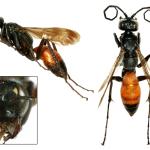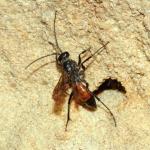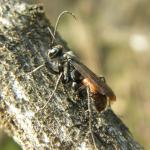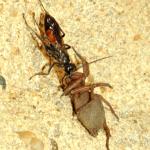One of our largest pompilids, and until recently, regarded as one of our rarest.
click to enlarge
Modern records are almost entirely confined to coastal sites in south-west England and the heaths of Dorset and the New Forest, Hampshire. The number of recent records from Dorset is particularly encouraging. It appears to have disappeared from south-east England, though there is a recent record for Pamber Forest (North Hampshire).
This species is listed in the Red Data Book (Shirt 1987) as Rare (RDB3) and provisionally upgraded to Vulnerable (pRDB2) in Falk (1991). Work for this Atlas has revealed that it is more widespread than previously thought.
The wasp utilises a variety of habitats including coastal landslips and unimproved cliff tops, sandy heathland and sandpits.
The species is probably single-brooded; May-September.
The nest cells are mostly provisioned with large web-building spiders such as Agelena and Tegenaria (both Agelenidae) and Amaurobius (Amaurobiidae), though gnaphosids and lycosids are also reported.
The nesting habits have been described by Richards and Hamm (1939) and Day (1988). Multi-celled nests are made in existing cavities. In Poland, this species has been observed nesting in July in the burrows of small mammals, especially moles. These burrows acted as entrance chambers for the cells, which were excavated near to one another (though not actually joined). The female is very faithful to her nest, and is difficult to drive away. She uses the chamber for shelter during bad weather and at night. Similar observations have been made in central France.
Wild carrot, wild parsnip and yarrow are among those recorded.
1997





